Predicting Ischemic Stroke: Reducing Surgeries (And Mortality) In Elderly Patients At High Risk Of Stroke Due To Carotid Artery Stenosis

Carotid artery stenosis is the primary cause of up to 20 percent of ischemic strokes, which make up a considerable majority of all strokes. While stroke victims often undergo surgerical procedures to restore blood flow to their brains, use of such aggressive procedures in asymptomatic patients is often controversial, especially since the patients are generally very old. A new study finds cerebrovascular reserve (CVR) testing along with brain imaging can be a cost-effective way to identify patients at highest risk for stroke who might benefit from an aggressive intervention. "The study results show that imaging can be a cost-effective tool to stratify patients by risk of stroke and help sort patients into invasive, expensive interventions and less invasive options," said Dr. Ankur Pandya, assistant professor of healthcare policy and research and public health in radiology at Weill Cornell Medical College in New York City.
In the United States, an estimated 400,000 patients over 70 have asymptomatic carotid artery stenosis, which places them at a higher risk of stroke. Carotid artery stenosis is another name for “hardening of the arteries” or atherosclerosis — when the major blood vessels supplying oxygen to the brain begin to narrow due to a buildup of plaque. This so-called clogging of the arteries is caused by smoking, eating fatty foods, and lack of exercise. If doctors could find a cost-effective way to diagnosis this condition, they might be able to predict and prevent more strokes, by recommending the most effective treatment.
For the current study, Pandya and a team of researchers assessed the impact of CVR testing on patients with (asymptomatic) carotid artery stenosis. The question was, Can CVR, a low-cost measure of blood flow to the brain frequently used in Europe and Canada, help doctors make accurate predictions when treating these patients? To answer this question, Pandya and his colleagues constructed a mathematical model that allowed them to make accurate if hypothetical comparisons among three different approaches: 1/ CVR testing, 2/ immediate carotid endarterectomy (a surgical procedure that removes plaque from the arteries), and 3/ drug-based care with surgery only for those patients whose condition became worse.
"Our model takes all these pieces of information on risks, costs and benefits and does the math in a systematic way to help clinicians make decisions," Pandya explained. After assembling study participants into separate groups, each group began to receive one of the three treatment approaches. What did the research team discover?
The CVR-based approach led to about half of the patients undergoing surgery and appeared to have the most favorable balance of costs and benefits. The drug-based strategy led to the lowest lifetime costs and fewest surgeries, however, it also resulted in the lowest life expectancy. The immediate surgery strategy had the highest costs, by far, with only incremental health benefits when compared with the CVR-based approach.
"CVR testing with ultrasound could be used to stratify patients by risk based on abnormal blood flow patterns to the brain, and then other imaging tests like MRI could be employed to look at the composition and stability of plaque, which may give greater insight into those plaques most likely to rupture and cause symptoms," said Pandya. In short, CVR testing may be the new crystal ball for helping identify elderly patients at risk of stroke and the best treatment strategy.
Source: Pandya A, Gupta A, Kamel H, et al. Carotid Artery Stenosis: Cost-effectiveness of Assessment of Cerebrovascular Reserve to Guide Treatment of Asymptomatic Patients. Radiology. 2014.



























